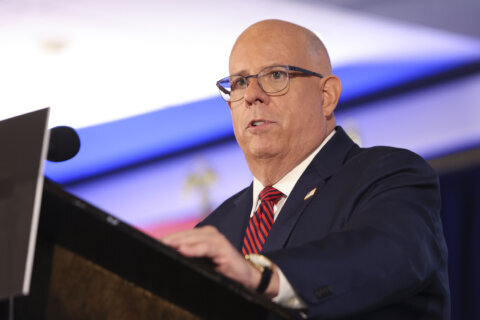Thousands of drivers are being caught speeding in the Maryland work zones closest to the D.C. region — and fines for violators have just doubled under a new law that went into effect earlier this month.
WTOP obtained the data on Maryland speeding tickets through a Freedom of Information Act request.
In the broader D.C. area, the Maryland State Highway Administration (SHA) has deployed speed cameras at work zones on:
- Route 100 westbound at the Baltimore-Washington Parkway in Hanover.
- Route 100 eastbound at the Baltimore-Washington Parkway in Hanover.
- Route 29 northbound at Broken Land Parkway in Columbia.
- I-95 southbound at Guilford Road in Columbia.
Since Aug. 7, 2023, the Route 100 westbound camera has given out 17,058 citations, according to state data as of June 7. The eastbound Route 100 camera started giving citations on Dec. 4, and as of last week has given out 4,131.
The camera at Route 29 has given out 7,772 citations since late January, according to state data.
As of last week, the newest camera of the group, at I-95 and Guilford Road, has issued 426 tickets since April 29.
While they’re giving tickets to thousands of drivers, state leaders say the goal of the program is to keep work zones safe.
“It is not a tool to issue citations,” Teri Soos, deputy chief operating officer with the Maryland SHA, told WTOP. “That is not what we’re looking for. We’re looking for compliance.”
Overall, as part of the state’s contract with its vendor, the agency has 10 cameras and can deploy them in about 20 locations, because they operate in eight-hour shifts.
The state has been using automated speed cameras in work zones since 2009. They’re often placed on roadways with speed limits of at least 45 mph that may be narrower or where there are confusing lane configurations. They could also be placed in areas where there’s a multi-year project and specific concern for worker safety.
The agency puts up signs indicating the photo enforcement and a speed feedback device, which tells drivers their speeds before getting to the part of the work zone where the camera is. Currently, there’s a 12 mph buffer before a camera issues a ticket.
“We want people to slow down for their own safety in work zones, as well as that of the workers on the roadways,” Soos said.
Fines doubled starting June 1
Earlier this year, Gov. Wes Moore signed the Maryland Road Worker Protection Act into law. That changed the fine of a work zone speed camera ticket from $40, which Soos said is among the lowest in the nation, to $80, effective June 1. In January, fines will be determined based on a tiered system that considers how fast above the speed limit a driver is going. Those fines will also double when there are workers present.
The revenue from speed camera tickets pays for the program, Soos said. Some of it goes to Maryland State Police, and under the new law, some will be allocated for the transportation trust fund to be used for safety projects.
As part of the changes, the State Highway Administration will also put blue lights on the cameras and use flashing lights when workers are on site.
“Once people get used to the work zone being placed, the signing there, and the placement of the camera, we do tend to see good compliance rates, about 99%,” Soos said.
In addition to the cameras, the agency is also using troopers in work zones. That serves as an additional warning for drivers to slow down, and police enforcement is “a better tool for us,” Soos said. However, police have limited resources, so their presence isn’t always consistent.
“More and more compliance is our goal,” Soos said. “We want drivers to be safe in our work zone.”
Last year, 12 people died in work zone crashes. So far this year, there have been eight, according to an agency news release. In many cases, Soos said, crashes in work zones lead to injuries or death for drivers and passengers more often than workers.
“About 20% of the time, it is a worker on the side of the roadway,” Soos said.
The legislation now in effect is one of the recommendations from the Maryland Work Zone Safety Work Group. Moore assembled the group following the March 2023 work zone crash that killed six highway workers on the Baltimore Beltway.
Get breaking news and daily headlines delivered to your email inbox by signing up here.
© 2024 WTOP. All Rights Reserved. This website is not intended for users located within the European Economic Area.








